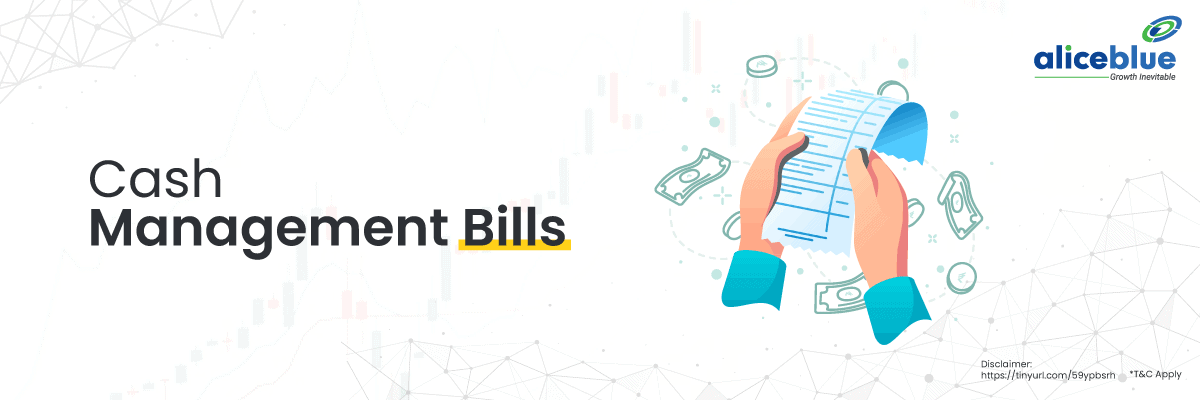Cash management bills (CMBs) are government-issued short-term debt instruments in India that serve as a means to address transient cash shortages. They are a crucial component of the money market in India and provide investors with a safe and sound investment channel.
CMB Full Form
The full form of CMB is “Cash Management Bill.” CMBs are financial instruments employed by the Reserve Bank of India (RBI) on behalf of the Indian government to procure funds for shorter durations than other types of government securities in order to address immediate and temporary liquidity needs.
Cash Management Bills Example
To easily understand cash management bills, let us look at an example. Imagine that the Indian government thinks it will have a short-term cash shortage because of a delay in getting its taxes. To make up for this lack of cash, the RBI announces the release of Cash Management Bills on behalf of the government. When an investor sees a chance for a safe short-term investment, they buy INR 10 crores worth of CMBs with a 60-day maturity period. At the end of the maturity period, the investor gets the bills’ face value. The difference between the discounted purchase price and the face value is what the investor made.
Features of Cash Management Bills
One of the most significant features of CMBs is their capacity to assist the government in meeting its urgent liquidity needs. Other features include:
- Short-term Nature: Typically, CMBs have a maturity period of less than 91 days.
- Discounted Price: CMBs are issued at a discount and redeemed at face value, meaning investors earn the difference as profit.
- Safe Investment: CMBs are regarded as an extremely low-risk investment because the government backs them.
- Flexibility: The frequency and amount of CMB issuance vary based on the government’s liquidity needs.
Cash Management Bill Vs Treasury Bill
The primary difference between a Cash Management Bill and a Treasury Bill is that the CMBs address immediate liquidity needs, while T-bills are used for regular debt management.
| Parameter | Cash Management Bill | Treasury Bill |
| Purpose | Meets immediate liquidity needs | Regular debt management |
| Maturity | Less than 91 days | Ranges from 91 to 364 days |
| Issuance | Irregular, based on need | Regular intervals |
| Amount | Varies based on government’s cash requirement | Fixed based on borrowing calendar |
| Discounted Price | Issued at a discount, redeemed at face value | Similarly, issued at a discount, redeemed at face value |
| Risk | Very low (backed by government) | Very low (backed by government) |
Cash Management Bills Minimum Amount
When it comes to their issuance values, CMBs usually have a set structure. Typically, the starting bid amount for these bills is INR 10,000. This means that if an investor wishes to invest in CMBs, they need to start with at least this amount. Additionally, any further investments in these bills should be in multiples of this base amount. So, if an investor wants to invest more, they could bid for INR 20,000, INR 30,000, and so on.
However, it’s important to note that these values aren’t rigid. The RBI, based on the specific liquidity conditions and requirements at the time of the auction, might set different minimum and maximum bid amounts.
Imagine a scenario where the RBI sees a temporary liquidity crunch in the market, and they decide to issue CMBs to manage this situation. The auction guidelines for this particular issuance specify a minimum bid amount of INR 10,000. An investor, Mr. Sharma, who wants to invest in these bills, could start his bid at INR 10,000. If he wants to invest more, he could bid for INR 50,000, which is in multiples of the base amount. Another investor, Ms. Patel, could decide to bid for INR 1,00,000, again adhering to the multiple structure. However, in another auction, the RBI might set a different minimum bid amount, say INR 20,000, based on the prevailing conditions and requirements. In such a case, the investors would need to adjust their bids accordingly.
Cash Management Bills Maturity
The maturity period of CMBs is short of 91 days. Their method of operation is a discounted redemption system. Just like Treasury Bills, they are issued at a discount and are redeemed at face value upon maturity. In other words, the investor made money when the price they paid for it was less than its face value.
How To Buy Cash Management Bills?
- Open a Demat Accoun: First and foremost condition is that you need Demat Account. You can open this account with a platform like Alice Blue which is required for electronic holding of the bills.
- Participate in Auctions: RBI periodically announces auctions for CMBs.
- Place a Bid: Depending on the auction format, bid for a specific amount and rate.
- Successful Bidders: On winning the bid, transfer the amount to the specified account.
- Receipt of Bills: After successful payment, CMBs are credited to the Demat account.
- Maturity: Upon maturity, the face value of the bills is credited back to the investor’s account.
We hope that you are clear about the topic. But there is more to learn and explore when it comes to the stock market, commodity and hence we bring you the important topics and areas that you should know:
What is a cash management bill – Quick Summary
- CMBs, or cash management bill, are a form of short-term debt instrument that the Indian government uses.
- “Cash Management Bill” is the full form of CMB.
- They address immediate liquidity needs, as shown in our case study.
- Their significant features include their short-term nature, issuance at discounted prices, and being a secure investment.
- The main difference between CMBs and T-bills is their purpose and issuance frequency.
- Typically, the minimum bid for CMBs is INR 10,000.
- With a maturity of less than 91 days, they’re redeemed at face value.
- Purchasing CMBs involves opening a demat account, participating in RBI auctions and some other steps.
- Investing in stocks, mutual funds, and IPOs through Alice Bue is completely free. We offer Margin Trade Funding, which allows you to purchase stocks on a fourfold margin, i.e., stocks worth ₹10,000 for ₹2,500.
Cash Management Bills – FAQs
What is a cash management bill?
Cash Management Bills (CMBs) are short-term financial instruments issued on behalf of the Indian government by the Reserve Bank of India. The primary objective of this instrument is to rectify temporary and urgent cash shortages that the government may encounter; thus, it is an indispensable instrument for effective financial management.
Who can issue cash management bills in India?
Cash Management Bills are issued under the authority of the Reserve Bank of India (RBI) in India. It fulfils this function on behalf of the Indian government in situations where immediate liquidity is required.
What is the difference between treasury bills and cash management bills?
The main difference between treasury bills and cash management bills is that while treasury bills are regularly issued financial instruments catering to the government’s regular debt management needs, cash management bills are issued irregularly to address immediate and temporary liquidity needs of the government.
What is the history of cash management bills?
Cash Management Bills were created to temporarily bridge the government’s cash flow gap. The RBI introduced CMBs to maintain liquidity without disrupting Treasury Bill borrowing due to government expenditure-receipt discrepancies. CMBs have become an essential tool for the government to efficiently manage its finances and avoid short-term liquidity issues that could impede its projects and commitments.
To understand the topic and get more information, please read the related stock market articles below.



